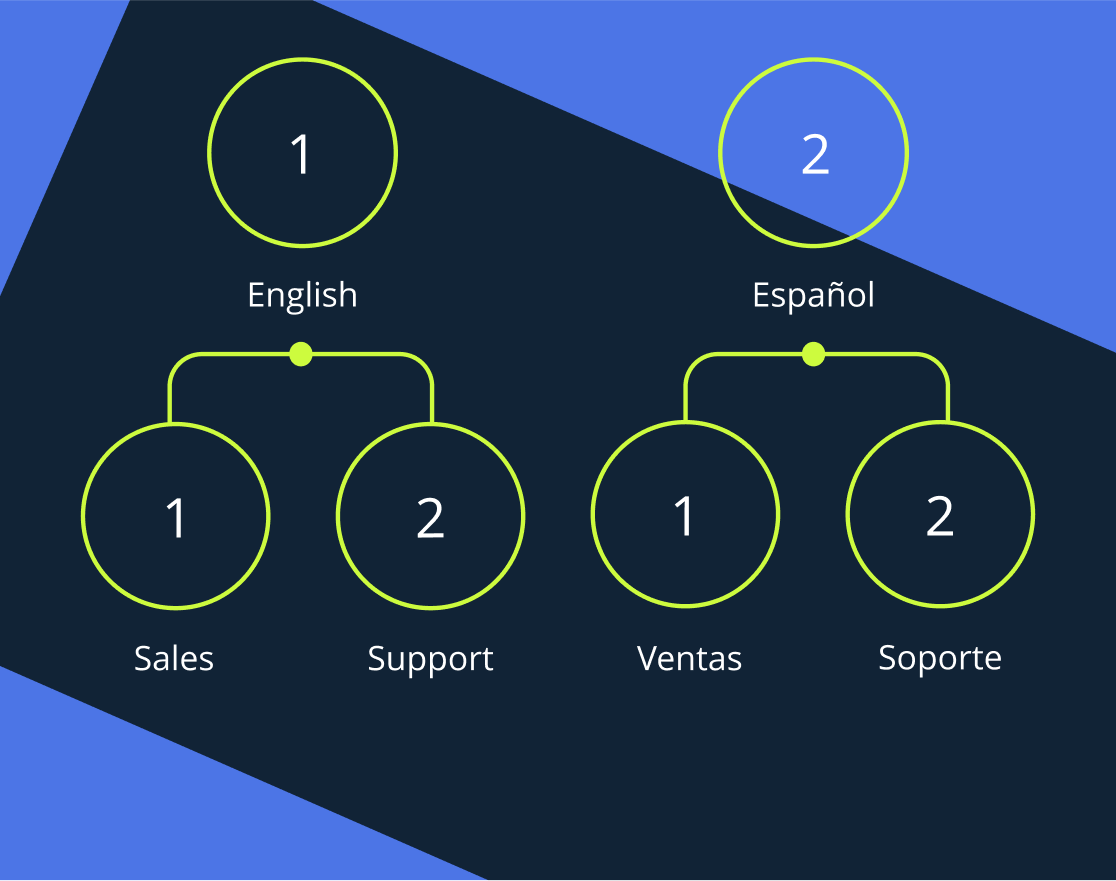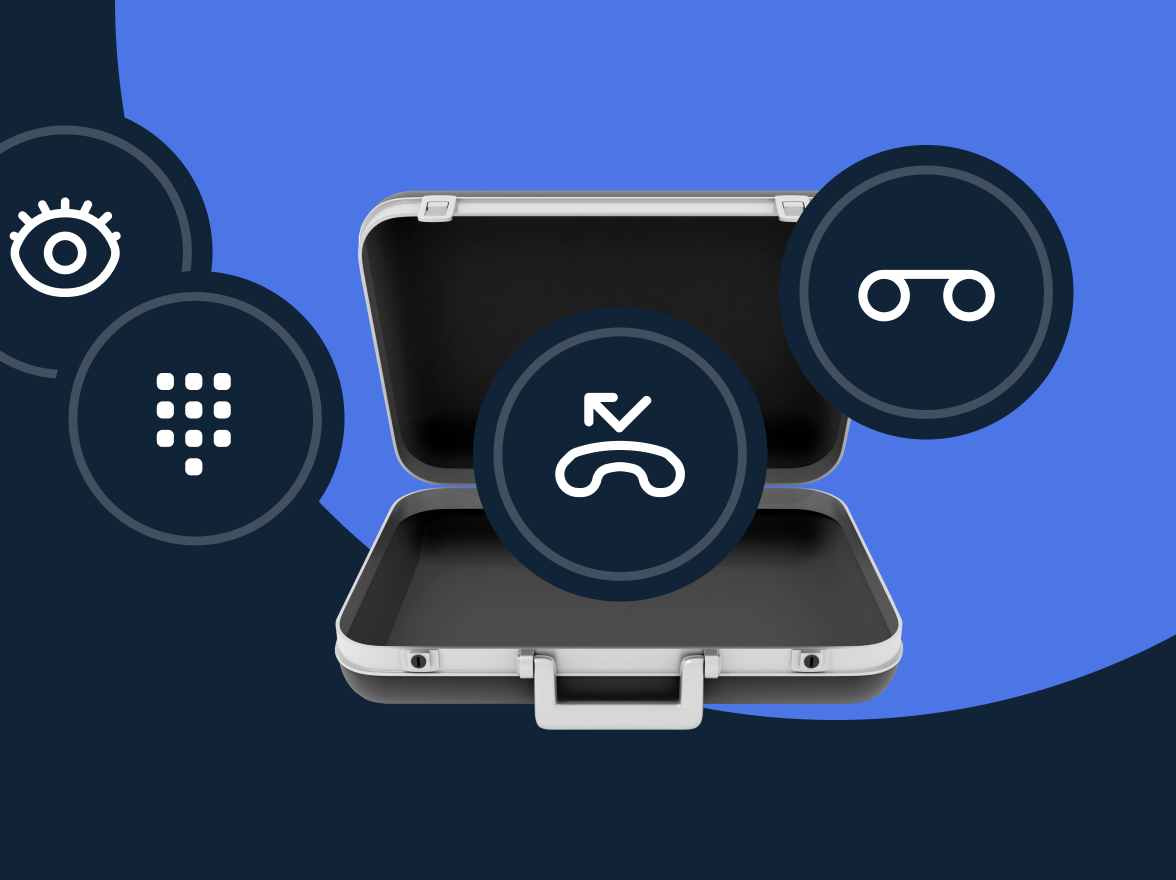Think about all the times you’ve called a business or a bank and had to go through the endless menu options. Nobody wants to build a phone menu that’s tedious and uninspiring, but it’s a fate many succumb to. This results in 88% of customers insisting that they want to talk to a live person over the phone when they have a problem or a question.
The key to guiding your customers to the correct department without causing irritation is to have a quick and convenient automated phone menu. How do you do that? Discover it below!
Navigate:
- What is a phone menu?
- Types of phone menu options
- Practical uses of phone menus
- What call menu aspects are the trickiest for callers?
- 12 ways to create an engaging phone menu
- How to set up a phone menu?
- Benefits of call menu options
- What call menu features should you look for?
- Use your automated phone menus to engage, not enrage callers
What is a phone menu?
A phone menu is an automated voice service, also called IVR (Interactive Voice Response). It is used to route calls to the appropriate person, department, or office branch and can also be used to provide information. Any person who has called a business and heard “Press 1 for X, Press 2 for Y” has encountered the business phone menu (and, being honest, has been frustrated by it on more than one occasion).
Types of phone menu options
Phone menu options, or Interactive Voice Response systems, route incoming calls to the appropriate departments or agents. Here are the main options:
Levels:
- Single-level: This basic IVR menu provides a simple guide with a few options. Callers press a number to be directed to the relevant department. It’s ideal for small businesses with simple call routing needs.
- Multi-level: Multi-level option offers additional layers, allowing for more detailed routing. After an initial selection, callers may choose further options to narrow their request. Useful for larger organizations with multiple departments.
Types:
- Time-based routing: This phone menu option routes calls based on the time of day. Calls made after business hours might go to voicemail or an after-hours support team. It helps manage call flow and provides appropriate responses based on the call time.
- Skill-based routing: Calls are directed via the phone menu solution to agents based on their expertise and skills, ensuring customers connect with agents best suited to handle their inquiries, improving first-call resolution rates and satisfaction.
- Geographic routing: This phone system feature routes calls based on the caller’s location, connecting them with the nearest or most relevant office or agent, beneficial for companies with multiple locations.
- Priority routing: High-value customers or VIP clients are directed to specific agents or a dedicated support team, ensuring quick and personalized service for important clients.
- Dynamic options: This type of calling menu options adjusts based on real-time information, such as agent availability or current call volumes, helping manage call flow and reduce wait times by offering relevant options.
- Voice recognition: Allows callers to speak their selections, enhancing user experience and supporting a more natural interaction with the system.
- Callback options: Offers callers the choice to receive a callback instead of waiting on hold, improving satisfaction by reducing wait times and offering convenience.
Practical uses of phone menus
Phone options help businesses manage incoming calls by directing customers to the right department quickly. Here are some essential uses of automated phone menu systems:
- Greeting customers: You can welcome callers with automated greetings that provide essential information. For example, a phone menu greeting might offer details about business hours, locations, or the option to speak with a customer service representative. This ensures that customers receive immediate assistance without waiting.
- Call transfers: You can transfer calls automatically, saving time for both customers and staff. Customers can choose the department they need from the menu, and the system will direct the call accordingly. This reduces the need for manual call transfers and improves call handling.
- Directing to the right department: Allow callers to select the appropriate department based on their needs, minimizing the frustration of being transferred multiple times. This feature ensures that customers are connected to the right department on their first attempt, improving their experience.
- Self-service options: Include self-service features that address common inquiries such as checking account balances, making payments, or obtaining status updates. This enables customers to get the information they need quickly, reducing the load on live agents.
- Handling high call volumes: During busy periods, call options help manage high call volumes by offering automated responses to frequently asked questions and routing calls. This reduces wait times and ensures that calls are addressed quickly.
- Multilingual support: Provide language options, allowing customers to select their preferred language for assistance. This ensures that businesses can serve a diverse customer base, improving communication and service quality.
What call menu aspects are the trickiest for callers?
Vonage conducted a deep report with a spooky name: “The horrors of IVR: five key issues” where people shared the things they hate most about automated menus. Though this may sound like awful news for a business, in fact knowing what “not to do” is the best way to do something well.
According to the above report, here’s what irks customers most about calls:
- The caller’s reason for inquiry is not among the call menu options (65% of complaints)
- Listening to irrelevant options (63% of complaints)
- Can’t get through to a live operator (54% of complaints)
- The phone menu is too long (46% of complaints)
- It wastes their time (35% of complaints)
Sending callers to voicemail isn’t a viable solution, either. According to Forbes, 80% of callers who end up at a voicemail don’t leave a message. Why? Well, younger generations prefer messaging, while others skip them because they doubt they’ll ever get a callback.
12 ways to create an engaging phone menu
Creating an engaging voice welcome guide is crucial for improving the customer experience and ensuring successful call handling. Here are 12 tips to help you design a menu that keeps callers satisfied and your operations running smoothly:
1. Keep it simple
Avoid overwhelming callers with too many options. Manage the phone menu by limiting it to a maximum of five choices to ensure that customers can easily remember and select the appropriate option. Simplifying the options helps reduce confusion and speeds up the call routing process.
2. Prioritize live operator access
Many callers prefer speaking to a live operator. Make this option easily accessible, ideally as the first choice in your menu, to enhance customer satisfaction and reduce frustration. Providing quick access to a live person can significantly improve the caller’s experience and resolve issues faster.
3. Use caller ID for smart routing
Use caller ID to identify repeat customers and route their phone calls to the appropriate department or representative, improving personalized service and reducing wait times. This approach ensures that customers feel recognized and valued, leading to better service continuity.
4. Professional voice recordings
Use professional phone menu recordings for your call center. A clear, friendly, and professional-sounding voice can make the greeting guide more pleasant and easier to navigate. Professional recordings can also enhance the perception of your company’s reliability and quality.
5. Match your brand’s tone
Ensure that the voice and style of your greeting guide match your brand’s identity. Whether it’s formal or casual, aligning the tone with your brand helps create a cohesive customer experience. Consistency in branding across all customer touchpoints strengthens brand recognition and trust.
6. Regular updates and testing
Regularly review and update the phone menu for small businesses to reflect any changes in your services or departments. Conduct periodic tests to ensure all options work correctly and the sound quality is clear. Keeping your options current prevents outdated information from frustrating callers.
7. Analyze call data
Use analytics to monitor which options are most frequently selected. This information can help you optimize the layout and improve the overall customer experience by prioritizing the most common requests. Data-driven adjustments ensure your calling guide remains relevant and user-friendly.
8. Include self-service options
Incorporate self-service options for common auto attendant inquiries, such as checking account balances or business hours. This reduces the need for agent interaction and speeds up resolution times for simple requests. Offering self-service options empowers customers and reduces call volume.
9. Provide updates on current issues
If there’s a known issue, such as a service outage, inform callers upfront. This transparency helps manage expectations and can reduce the volume of phone calls that agents need to handle directly. Keeping customers informed can prevent frustration and improve trust.
10. Ensure multilingual support
If you serve a diverse customer base, offer phone menus in multiple languages. This inclusion ensures that non-native speakers can navigate the menu easily and receive the help they need. Multilingual support broadens your service reach and caters to a wider audience.
11. Optimize for mobile users
Design your telephone menu with mobile users in mind. Ensure there are adequate pauses between options to allow users time to move their phones from their ears to select an option. This consideration makes the calling guide more user-friendly for callers using mobile devices.
12. Test different structures
Experiment with different structures and gather feedback from customers to see which configuration works best when you set up your phone menu. Regularly refining your approach based on real user data can significantly improve the system’s effectiveness. Customer feedback is crucial for continuous improvement.
By following these best practices, you can create a welcome that is user-friendly, organized, and aligned with your business goals, ultimately leading to higher customer satisfaction and smoother call handling operations.
Consistently refining your phone menu based on customer feedback and performance analytics will ensure that it remains effective and continues to meet the needs of your customers and your business.
How to set up a phone menu?
Setting up a menu should be rather simple. Follow these steps to configure your options:
Step 1: Log into your account
Begin by logging into your software provider account. Navigate to the dashboard to access various settings and features for your phone system.
Step 2: Access the IVR settings
Go to the “Call Flow” section and select “Incoming Calls.” Locate the voice greetings player. Choose the default phone menu greeting or record and upload your own if your service provider offers that option.
Step 3: Create a new phone menu
Find the “Voice Menu” to access options with numbers 1, 2, etc., and a sign for adding actions.
Step 4: Set timeout actions
Select an action for when a caller does not make a selection within a certain timeframe. This could be directing the call to a voicemail or a default department.
Step 5: Save changes and test
Save your settings. Test the phone menu to ensure that all options work correctly and that calls are routed as intended. Adjust as necessary for clarity and functionality.
For different greeting guides for non-working hours or VIP clients, repeat steps 3-6 for those sections in the settings. If you feel like you need additional support, you can use a service that provides a free white-glove setup and demos.
Benefits of call menu options
Improved customer experience
Call options allow customers to quickly reach the department or service they need without speaking to multiple agents. This reduces wait times and frustration, providing a smoother and more satisfactory experience. Clear and concise options ensure that customers feel their time is valued and their needs are addressed.
Reduced workload on agents
By automating call routing, call menus decrease the workload on agents. They spend less time manually transferring calls and more time resolving customer issues. This leads to a more productive workforce and better use of resources. Automating routine inquiries with pre-recorded messages also frees up agents for more complex tasks.
Better call management
Greeting guides provide detailed insights into call patterns and customer preferences. Businesses can use their phone menu systems to track which options are most frequently selected and adjust their services accordingly. This data helps in managing call flow and handling inbound calls, leading to better resource allocation and service delivery.
Consistent service quality
Automated phone call menus ensure that every caller receives the same level of service regardless of the time of day or agent availability. This consistency helps maintain high service standards and builds customer trust. Additionally, it allows businesses to provide 24/7 support for basic inquiries, improving customer satisfaction and loyalty.
Enhanced business insights
Phone systems generate valuable data on customer interactions and preferences. By analyzing this information, businesses can identify trends, pinpoint areas for improvement, and make informed decisions to refine their services. These insights contribute to strategic planning and enhance overall operations.
What call menu features should you look for?
With how VoIP works, it is very important to understand the additional benefits cloud-based calling can offer. And when customizing your call menu, it’s essential to include features that improve customer experience and operational success. Here are some important features for your call center functions:
- Automatic call routing: Direct calls to the right department or agent based on the caller’s selection, reducing wait times and connecting customers quickly.
- Professional greetings: Use pre-recorded or custom phone menu greetings that are clear and friendly to create a positive first impression and provide necessary information right away.
- Multilingual support: Create a phone menu option for each language you cater to, ensuring everyone can navigate the menu and receive assistance in their preferred language.
- Self-service options: Allow callers to perform simple tasks such as checking account balances, making payments, or getting business hours without needing to speak to an agent.
- Caller ID recognition: Use caller ID to identify repeat customers and route their calls to the appropriate representative or department for personalized service.
- Voicemail options: Provide callers the option to leave a voicemail if they can’t wait on hold, ensuring their message is received and can be addressed later.
- Call queue management: Implement features to manage high call volumes, such as call queuing with estimated wait times and hold music to keep callers informed and engaged while they wait.
- Real-time updates: Inform callers of any current issues or important updates, such as service outages, to manage their expectations and reduce unnecessary calls to agents.
- Analytics and reporting: Track call patterns and menu option selections to optimize the automated phone menu structure and improve service based on real data.
These features help create a more user-friendly call menu system, improving both customer satisfaction and business operations.
Use your automated phone menus to engage, not enrage callers
Remember this: keeping an existing client is significantly easier and cheaper than attracting new ones. As previously mentioned, callers generally don’t trust voicemails to be returned, and voicemail itself is a huge productivity drain for workers. In fact, some major companies, such as Coca-Cola and JP Morgan & Chase have all but eliminated landline voicemail boxes for their employees.
With every lost call down the phone tree, you lose a potential customer. Don’t risk that. Build your call menu following the advice above to route calls quickly, painlessly, and intelligently to your employees so callers don’t have a reason to be aggravated. At a time when customers are increasingly demanding better service, your greeting has never been more important.





























